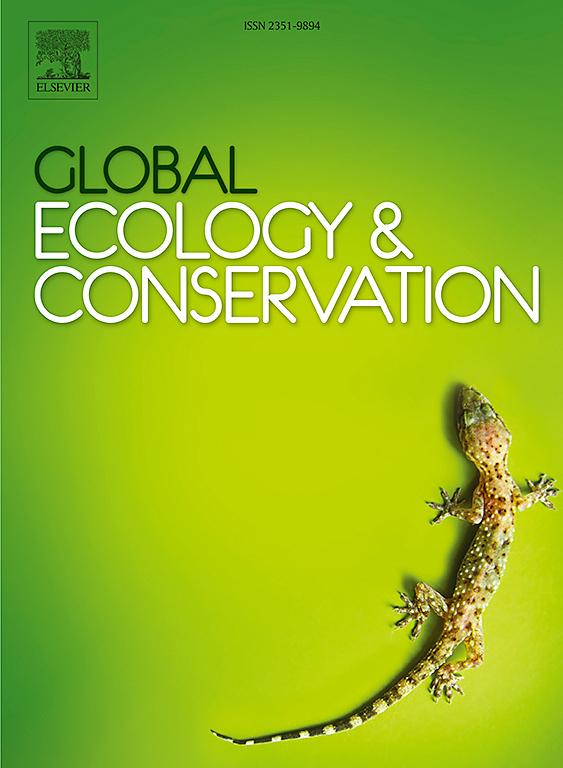Mapping the landscape of livestock depredation: local perceptions as an indicator of conflict severity in north-western Bhutan
IF 3.5
2区 环境科学与生态学
Q1 BIODIVERSITY CONSERVATION
引用次数: 0
Abstract
Conflict between humans and wild animals accelerates the decline of biodiversity worldwide. The livelihoods of local communities who depend on livestock are threatened when their livestock are killed, often leading to retaliation killing and endangering wild species. Documenting where people experience the greatest threat of predation of their livestock can support the development of policies and management practices for preserving wild species and securing people’s livelihoods. Here, we used spatial modelling to map the perception of local people using interviews in and near Jigme Dorji National Park, in north-western Bhutan, and to identify the areas where they experience the highest severity of conflict from predation of their livestock. We found that the severity of conflict was more pronounced in highland than in lowland communities. As highlanders are semi-nomadic and livestock plays a crucial role in their livelihood, the results raise concerns about the coexistence of alpine rural communities and wildlife. Further, by integrating spatially explicit models of conflict severity (derived from local perceptions) with carnivore occupancy probabilities (data from camera trapping), we identified distinct spatial patterns of potential conflict-risk areas among carnivore species. The snow leopard (Panthera uncia) was associated with high potential conflict risk in most highland areas, the royal Bengal tiger (Panthera tigris tigris) in the southern region, and the wild dog (Cuon alpinus) and the Himalayan black bear (Ursus thibetanus laniger) primarily in the central region. Our mapping approach can support more focused conservation interventions, fostering peaceful coexistence between local communities and wild species.
绘制牲畜掠夺的景观:作为不丹西北部冲突严重程度指标的当地看法
人类与野生动物之间的冲突加速了全球生物多样性的下降。当牲畜被杀时,依赖牲畜的当地社区的生计受到威胁,往往导致报复性杀戮和危及野生物种。记录人们的牲畜遭受最严重捕食威胁的地方,有助于制定保护野生物种和保障人们生计的政策和管理做法。在这里,我们使用空间模型来绘制当地人的感知图,通过在不丹西北部的吉格梅多吉国家公园及其附近进行采访,并确定他们因牲畜被捕食而经历最严重冲突的地区。我们发现冲突的严重程度在高地比在低地社区更为明显。由于高地居民是半游牧民族,牲畜在他们的生计中起着至关重要的作用,研究结果引起了人们对高山农村社区和野生动物共存的担忧。此外,通过整合冲突严重程度的空间明确模型(来自当地感知)和食肉动物占据概率(来自摄像机捕获的数据),我们确定了食肉动物物种之间潜在冲突风险区域的不同空间模式。在大多数高地地区,雪豹(Panthera uncia)与高潜在冲突风险有关,南部地区是皇家孟加拉虎(Panthera tigris tigris),中部地区主要是野狗(Cuon alpinus)和喜马拉雅黑熊(Ursus thibetanus laniger)。我们的测绘方法可以支持更有针对性的保护干预措施,促进当地社区和野生物种之间的和平共处。
本文章由计算机程序翻译,如有差异,请以英文原文为准。
求助全文
约1分钟内获得全文
求助全文
来源期刊

Global Ecology and Conservation
Agricultural and Biological Sciences-Ecology, Evolution, Behavior and Systematics
CiteScore
8.10
自引率
5.00%
发文量
346
审稿时长
83 days
期刊介绍:
Global Ecology and Conservation is a peer-reviewed, open-access journal covering all sub-disciplines of ecological and conservation science: from theory to practice, from molecules to ecosystems, from regional to global. The fields covered include: organismal, population, community, and ecosystem ecology; physiological, evolutionary, and behavioral ecology; and conservation science.
 求助内容:
求助内容: 应助结果提醒方式:
应助结果提醒方式:


